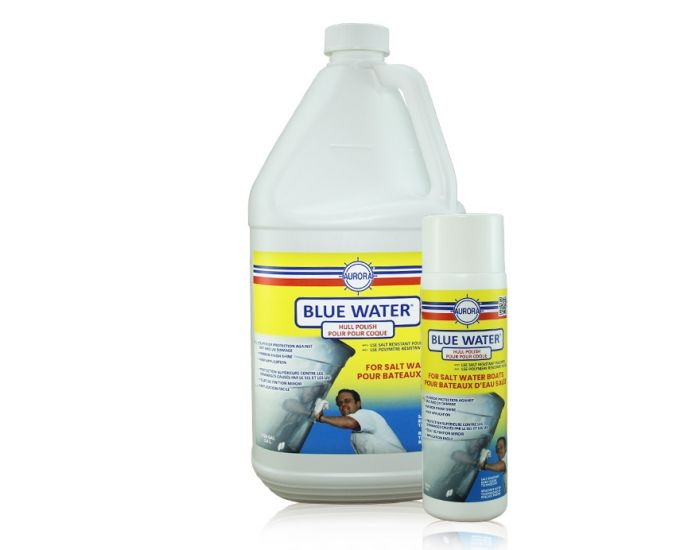- Thoroughly clean your boat hull, above the waterline, and remove any old wax.
- If your fiberglass boat hull has water stain, remove it with WATERLINE STAIN REMOVER®. If your Painted Hull has water stain, remove it with ALGEX®.
- To clean and strip old wax from Gelcoat and Painted Hull Surfaces, use BOAT CLEAN PLUS® and a MARINE POWER MITT®
- Remove oxidation, stains and scuffs from fiberglass Gelcoat, with BOAT SCRUB® and a MARINE POWER MITT®.
- If your Gelcoat Boat Hull is badly oxidized or has salt etching in the surface, buff the surface with the EZ BUFF® System until the original shine is restored. Severe salt etching may require wet sanding.
- Remove oxidation from painted hulls with KWIK SHINE®.
- Apply 1 coat BLUE WATER HULL POLISH® with a damp sponge. When it begins to haze up, wipe away the haze with a terry towel or microfiber cloth. Buffing with a lamb’s wool pad is optional.
- After 24 hours, apply a 2nd coat of BLUE WATER HULL POLISH®, as above.
- After 48 hours, launch your boat.
- MAINTENANCE: After each outing, when you return to your dock or trailer, rinse the hull with fresh water and wipe dry, if possible. Salt can’t stick to BLUE WATER HULL POLISH® and will fall off the hull.
Why is sea water so corrosive to boat hulls?
In a word, SALT!
Comprised primarily of sodium chloride, salt is among the most destructive element on Earth. When in solution with water, it dissociates into its chemical elements; sodium ions and chloride ions. Chloride ions are highly corrosive plus they have deep penetrating power. The corrosion that takes place is in the form of pits. That’s why the destructive etching on gel coat and paint is in the form of spots or pits.
In a perfect world, after each outing into the ocean, you would haul the boat and wash it down with fresh water and a special salt remover chemical and then dry it thoroughly. But, we all know, that this is inconvenient, time consuming and impractical so the best your boat gets is a quick rinse with fresh water when the boat is back at dock or on the trailer. Unfortunately, as soon as the water evaporates, salt spots appear that are abrasive, corrosive and hydroscopic (attracts water moisture to re-activate its corrosive nature); eating away, first through the wax or polish and then etching and eating its way into your gel coat or paint.
So, how can you protect your boat hull against salt water damage?
BLUE WATER HULL POLISH®
BLUE WATER HULL POLISH with LSE®, Rinse Clean Technology, is Hydrophobic, which makes it difficult for water, or salt water, to stick. Hydrophobic means that it hates water, both salt and fresh, and repels it.
Water, because it’s a polar molecule, is tenaciously Adhesive and want’s to stick to everything it comes into contact with; it’s also Cohesive, which causes it to stick to itself to form sheets of water, or drops, puddles, rivers, lakes and oceans. But, water and salt does not stick to BLUE WATER HULL POLISH, because LSE is Hydrophobic. It hates, and repels, salt water!
Now, when your boat is back at dock or on the trailer, all you need to do is give the hull a quick rinse with fresh water and any remaining salt crystals will simply fall off. Even the rinse water will bead up on the surface and fall off, leaving your hull clean, dry and protected, with very little effort on your part.
COVERAGE
16 oz Bottle: 400 sq. ft. One coat. Two coats required 1 US Gallon: 3,200 sq. ft. One coat. Two coats required
Why do Salt Water Boats get such a bad rap?
CORROSION!








